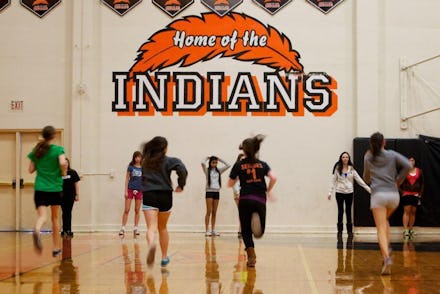The True Damage Racist Mascots Do to Native American Children

Pro tip: Here's how to create a hostile learning environment for young Native Americans:
"Siouxper Drunk" t-shirts, University of North Dakota. Image Credit: Last Real Indians
Assuming there's still any doubt, the Center for American Progress has published a report linking Native mascots to "lower self-esteem and mental health" in indigenous adolescents.
Image Credit: Oregon Live
The paper claims these stereotypes are often seen as factual and fuel "cultural biases and prejudices" among children of all backgrounds.
This is bad news for everyone. Understanding why is key to unlocking some of America's more troubling statistical patterns.
The numbers: Young Natives regularly face brutal attacks on their self-esteem and well-being.
Besides enduring 36.5% poverty rates — much higher than the under-18 U.S. average of 22.2% — they're also plagued by suicide rates a startling 2.5 times the norm for Americans 18-34. These figures are compounded by high rates of substance abuse, with 18.3% of Native eighth graders reporting binge drinking compared to the national average of 7.1%.
Image Credit: Getty
This eventually bodes poorly for adulthood: Natives die of chronic liver disease at 368% the national rate and diabetes at 177% the average.
Then there's school: As if that weren't enough, Native youth face the lowest graduation rates of any American ethnic group, at 67% in 2011–12. According to the report, they're the only kids to graduate at lower rates that year than the year prior.
Image Credit: Indian Country Today Media Network
Which brings us to the crux of the issue. Namely, how can we continue justifying said mascots (hello, Washington) in economic and "traditional" terms at high schools, colleges and pro sports organizations nationwide when children's well-being might be at stake?
Much of the report's substance stems from findings published by the American Psychological Association in 2005. It found that these mascots are harmful because they're restrictive.
"[T]hey remind American Indians of the limited ways in which others see them," says Dr. Stephanie Fryberg of the University of Arizona. "This in turn restricts the number of ways American Indians can see themselves."
Image Credit: AP
This impact isn't restricted to aboriginal students, either. For an illustration of the behavior this limited perspective can breed among their peers, read this anecdote from a California high school student:
"Our cheerleaders dressed up one of our own [students] in a Halloween 'Pokeahottie' costume and tied her to a stake after dragging her out on the field in shackles against her will. They proceeded to dance around her, acting as if they were beating her and treating her like a slave. This is the most sickening halftime show I've ever witnessed."
The routine degradation bred by the stereotyping and commodification of Native culture is a problem with likely devastating consequences. Yet it persists in schools and organizations nationwide.
Perhaps the most ironic illustration of its callous ignorance is the story of Kaden Tiger, a Native student whose Oklahoma high school tried to stop him from wearing a traditional feather to his graduation ceremony.
The school's mascot? A "feather-headdress-wearing chieftain."